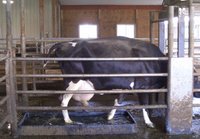 Newswise (07/10/06) — Commonly used foot baths to prevent lameness in dairy cows may not only reduce crop yields but also contribute to the copper load in farm fields. To look at how the use of the foot baths' copper sulfate affects three crops' quality and yields and to give farmers an idea of how much copper may be kept in field soil, a research project, funded by the Northern New York Agricultural Development Program (NNYADP), which is supported, in part, by Cornell University, is now under way.
Newswise (07/10/06) — Commonly used foot baths to prevent lameness in dairy cows may not only reduce crop yields but also contribute to the copper load in farm fields. To look at how the use of the foot baths' copper sulfate affects three crops' quality and yields and to give farmers an idea of how much copper may be kept in field soil, a research project, funded by the Northern New York Agricultural Development Program (NNYADP), which is supported, in part, by Cornell University, is now under way.Copper sulfate is the most cost-effective treatment for controlling hairy heel warts that cause lameness in dairy cows. However, much of the copper sulfate used in the cows' foot baths is disposed of in manure slurry applied to farm fields. A William H. Miner Agricultural Research Institute survey of New York and Vermont farms estimates that 4 to 16 pounds of copper sulfate is applied per acre per year to some fields. Since the New York State Department of Environmental Conservation has set a lifetime load limit for copper at 74 pounds per acre, a field could reach its maximum load of copper in 4.5 to 19 years. Over those years, a farmer hopes to harvest maximum crop yields.
Researchers at the Miner Institute in Chazy, N.Y., are evaluating timothy and orchard grass grown in greenhouses using controlled applications of copper sulfate on sandy loam and silt loam soils. A field study on corn is also under way.
"What we want to know is how much and how well copper sulfate is tolerated by field crops," says Everett D. Thomas, vice president of agricultural programs at the institute. "We know of no research that determines how copper in sulfate form affects crop development on different soils. The data from our project will determine how the rate of copper sulfate application affects root growth, forage quality and yield."
Thomas says farmers can consider several alternatives to reduce their use of copper sulfate to protect the environment and obtain desired crop yields while protecting cow foot health. Those alternatives include adjusting the amount of copper sulfate used in foot baths, reducing the frequency of foot baths, using them less in the winter and improving hoof trimming and stall surfaces.
The Miner Institute, he said, was able to reduce its copper sulfate use by 60 percent and maintain its dairy herd's hoof health through good hoof trimming practices and use of rubber mats throughout the milking barn.
While Thomas says it is too early to release results, "some of the results from the greenhouse study on the forage grasses were eye-opening -- big yield decreases where copper sulfate was used." He is eager, he said, to see the field corn study results.
The NNYADP is a farmer-driven research and education program specific to New York's six northernmost counties (Essex, Clinton, Franklin, Jefferson, Lewis and St. Lawrence), said R. David Smith, associate professor of agricultural and food systems sustainability at Cornell and program coordinator of NNYADP. The program receives support from Cornell's College of Agriculture and Life Sciences, Cornell's Agricultural Experiment Station and New York state through the efforts of northern N.Y. Sens. James Wright and Elizabeth Little, among other sources.
Photo: A Holstein steps through a copper foot bath at W.H. Miner Agricultural Institute in Chazy, N.Y. Such foot baths help control hairy heel warts that cause lameness in dairy cows. (credit: Debra LaPorte/W.H. Miner Agricultural Institute )




No comments:
Post a Comment